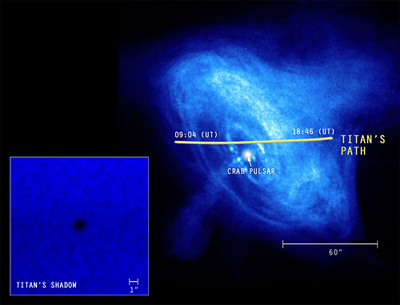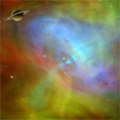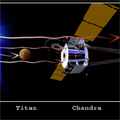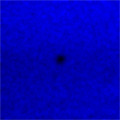April 5, 2004
CXC RELEASE: 04-03

Chandra/Hubble/Spitzer Composite Image of Kepler's Supernova Remnant
Chandra X-ray Image of Titan
Press Image and Caption
A rare celestial event was captured by NASA's Chandra X-ray Observatory as Titan -- Saturn's largest moon and the only moon in the Solar System with a thick atmosphere -- crossed in front of the X-ray bright Crab Nebula. The X-ray shadow cast by Titan allowed astronomers to make the first X-ray measurement of the extent of its atmosphere.
On January 5, 2003, Titan transited the Crab Nebula, the remnant of a supernova explosion that was observed to occur in the year 1054. Although Saturn and Titan pass within a few degrees of the Crab Nebula every 30 years, they rarely pass directly in front of it.
"This may have been the first transit of the Crab Nebula by Titan since the birth of the Crab Nebula," said Koji Mori of Pennsylvania State University in University Park, and lead author on an Astrophysical Journal paper describing these results. "The next similar conjunction will take place in the year 2267, so this was truly a once in a lifetime event."
Chandra's observation revealed that the diameter of the X-ray shadow cast by Titan was larger than the diameter of its solid surface. The difference in diameters gives a measurement of about 550 miles (880 kilometers) for the height of the X-ray absorbing region of Titan's atmosphere. The extent of the upper atmosphere is consistent with, or slightly (10-15%) larger, than that implied by Voyager I observations made at radio, infrared, and ultraviolet wavelengths in 1980.
"Saturn was about 5% closer to the Sun in 2003, so increased solar heating of Titan may account for some of this atmospheric expansion," said Hiroshi Tsunemi of Osaka University in Japan, one of the coauthors on the paper.
The X-ray brightness and extent of the Crab Nebula made it possible to study the tiny X-ray shadow cast by Titan during its transit. By using Chandra to precisely track Titan's position, astronomers were able to measure a shadow one arcsecond in diameter, which corresponds to the size of a dime as viewed from about two and a half miles.
Unlike almost all of Chandra's images which are made by focusing X-ray emission from cosmic sources, Titan's X-ray shadow image was produced in a manner similar to a medical X-ray. That is, an X-ray source (the Crab Nebula) is used to make a shadow image (Titan and its atmosphere) that is recorded on film (Chandra's ACIS detector).
Titan's atmosphere, which is about 95% nitrogen and 5% methane, has a pressure near the surface that is one and a half times the Earth's sea level pressure. Voyager I spacecraft measured the structure of Titan's atmosphere at heights below about 300 miles (500 kilometers), and above 600 miles (1000 kilometers). Until the Chandra observations, however, no measurements existed at heights in the range between 300 and 600 miles.
Understanding the extent of Titan's atmosphere is important for the planners of the Cassini-Huygens mission. The Cassini-Huygens spacecraft will reach Saturn in July of this year to begin a four-year tour of Saturn, its rings and its moons. The tour will include close flybys of Titan that will take Cassini as close as 600 miles, and the launching of the Huygens probe that will land on Titan's surface.
"If Titan's atmosphere has really expanded, the trajectory may have to be changed." said Tsunemi.
The paper on these results has been accepted and is expected to appear in a June 2004 issue of The Astrophysical Journal. Other members of the research team were Haroyoski Katayama (Osaka University), David Burrows and Gordon Garmine (Penn State University), and Albert Metzger (JPL). Chandra observed Titan from 9:04 to 18:46 UT on January 5, 2003, using its Advanced CCD Imaging Spectrometer instrument.
NASA's Marshall Space Flight Center, Huntsville, Ala., manages the Chandra program for the Office of Space Science, NASA Headquarters, Washington. Northrop Grumman of Redondo Beach, Calif., formerly TRW, Inc., was the prime development contractor for the observatory. The Smithsonian Astrophysical Observatory controls science and flight operations from the Chandra X-ray Center in Cambridge, Mass.
Additional information and images are available at:
MEDIA CONTACTS
Steve Roy
Marshall Space Flight Center, Huntsville, AL
Phone: 256-544-6535
Megan Watzke
Chandra X-ray Observatory Center, CFA, Cambridge, MA
Phone: 617-496-7998
cxcpress@cfa.harvard.edu





